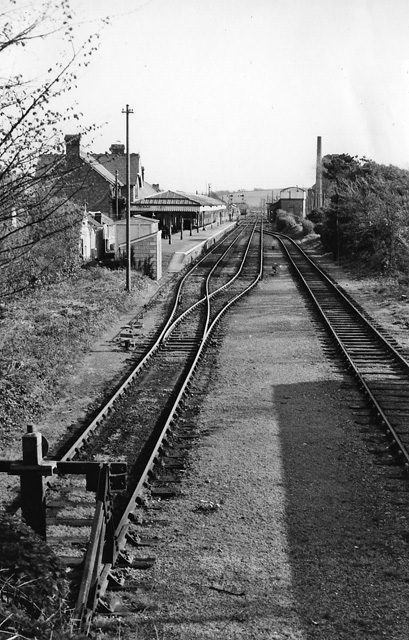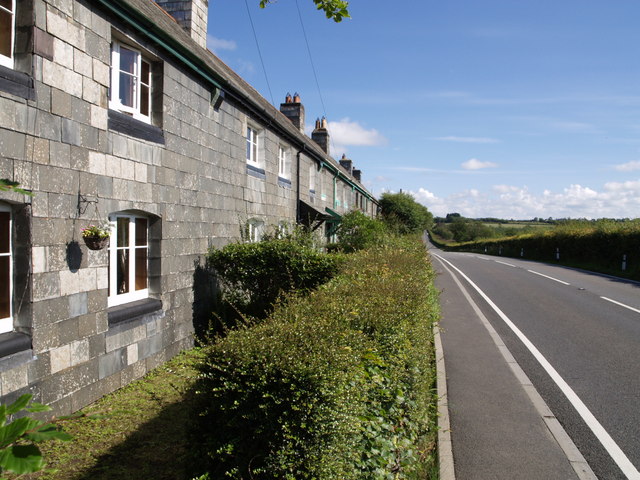|
Okehampton–Bude Line
The Okehampton–Bude line was a railway line built to serve Holsworthy, Devon, Holsworthy in Devon, and Bude on the Cornish coast near the Devon border in England. The line branched from the main line at Meldon Junction to the west of Okehampton on the northern edge of Dartmoor. The line opened in 1879 to Holsworthy and in 1898 to Bude. It is now closed. Location The Bude branch diverged from the London and South Western Railway (LSWR) main line from Exeter to Plymouth at Meldon Junction and ran to Bude () by way of Halwill and Holsworthy, Devon, Holsworthy. It crossed hilly terrain which was largely agricultural and sparsely populated. When the line was constructed it ran from Meldon Junction to Holsworthy. The line was extended to Bude on the Atlantic coast of Cornwall south of Hartland Point. The railway brought Bude prosperity as a watering place, and in the closing decades of the 19th century it became a holiday destination. Railway construction In 1871 the Devon and ... [...More Info...] [...Related Items...] OR: [Wikipedia] [Google] [Baidu] |
Holsworthy, Devon
Holsworthy is a market town and Civil parishes in England, civil parish in the Torridge District, Torridge district of Devon, England, west of Exeter. The River Deer, a tributary of the River Tamar, forms the western boundary of the parish, which includes the village of Brandis Corner. According to the 2011 census the population of Holsworthy was 2,641, growing to an estimated 3,287 in 2019. History Toponymy The original meaning of "Holsworthy" is probably "Heald's enclosure". Derived from the Old English personal name "Heald" or "Healda", plus "-worthig", an enclosure, farm or estate. An alternative possibility is from Old English "heald" meaning incline or slope. In 1086 the name was recorded as ''Haldeword'' and as ''Haldeurdi'' (Exon). Other recorded spellings are ''Haldwwurth'' 1228, ''Halleswrthia'' -worth(e) -wordi (late 12th–1291), ''Haldeswrthy'' -wrthi -worth (1277–1389), ''Holdesworthe'' (1308), ''Healdesworthe'' ( 1320), ''Hyallesworthi'' (1326), and ''Houlswor ... [...More Info...] [...Related Items...] OR: [Wikipedia] [Google] [Baidu] |
South Devon
South Devon is the southern part of Devon, England. Because Devon has its major population centres on its two coasts, the county is divided informally into North Devon and South Devon.For exampleNorth DevonanSouth Devonnews sites. In a narrower sense "South Devon" is used to refer to the part of Devon south of Exeter and Dartmoor, including Plymouth, Torbay and the districts of South Hams, West Devon and Teignbridge. South Devon is also sometimes, although incorrectly, taken to include East Devon, which includes the first seaside resort to be developed in the county, Exmouth and the more upmarket Georgian town of Sidmouth, headquarters of the East Devon District Council. National character area South Devon is more precisely defined as a natural region which has been designated as National Character Area 151 by Natural England. [...More Info...] [...Related Items...] OR: [Wikipedia] [Google] [Baidu] |
Widemouth Bay
Widemouth Bay () is a bay, beach and small village on the Atlantic Ocean, Atlantic Atlantic coast of Cornwall, coast of Cornwall, England, United Kingdom. It is about 3 miles (5 km) south of Bude. This stretch of coast is steeped in the smuggling history of times before, and not far south of Widemouth Bay can be found many little inlets and coves. Village The village of Widemouth Bay itself is a much more recent development, consisting mainly of bungalows built during the twentieth century. As well as a number of hotels, there are several cafes on and around the beach as well as a pub and shops on the hill above the bay. Widemouth Bay has a small church, Our Lady and St Anne's Church, Widemouth Bay, Our Lady and St Anne's, located on the landward side of the village. Activities The beach is popular for surfing and Human swimming, swimming and is patrolled in the summer by RNLI lifeguards. Several surfing schools operate on the beach because it has relatively gentle, ea ... [...More Info...] [...Related Items...] OR: [Wikipedia] [Google] [Baidu] |
Padstow
Padstow (; ) is a town, civil parishes in England, civil parish and fishing port on the north coast of Cornwall, England, United Kingdom. The town is situated on the west bank of the River Camel estuary, approximately northwest of Wadebridge, northwest of Bodmin and northeast of Newquay. The population of Padstow civil parish was 3,162 in the United Kingdom Census 2001, 2001 census, reducing to 2,993 at the 2011 census. In addition Padstow (electoral division), an electoral ward with the same name exists but extends as far as Trevose Head. The population for this ward is 4,434. The geology of the low plateau west of Padstow has resulted in such features as Tregudda Gorge where erosion along the faultline has caused sheer cliffs to form; and Marble Cliffs which has alternating dark grey and light grey strata. The Round Hole is a collapsed sea cave. History In English, Padstow was originally named after Æthelstan who was reported by John Leland (antiquary), John Leland to ... [...More Info...] [...Related Items...] OR: [Wikipedia] [Google] [Baidu] |
Atlantic Coast Express
The ''Atlantic Coast Express'' (''ACE'') is an express passenger train in England that has operated at various times between London and seaside resorts in the South West England. It is currently operated as a summer only service by Great Western Railway between London Paddington and Newquay. The origins After completion of the lines to Bude in 1898 and Padstow in 1899, the London & South Western Railway (L&SWR) introduced the first ''North Cornwall Express'' in 1900 leaving London Waterloo at 11:10, and this continued over the next decade as the ''North Cornwall & Bude Express'' with the departure time adjusted to 11:00 running during the summer only. By 1914 this train was running throughout the year, and outside the summer season carried through coaches to Padstow, Bude, Plymouth and , a presage of things to come. However World War I reduced both the scope for holidays and stretched the railway's resources, and after this the L&SWR did not pursue a policy of having a pr ... [...More Info...] [...Related Items...] OR: [Wikipedia] [Google] [Baidu] |
Bude Railway Station
Bude railway station () was the western terminus of the Bude Branch. It was opened in 1898 by the London and South Western Railway (LSWR) to serve the coastal town of Bude and closed in 1966 after having been proposed for closure in the Beeching Report. History The opening of Bude station in 1898 marked the completion of the LSWR's branch line from Okehampton which had taken nineteen years and four acts of Parliament. The original line had been authorised as far as Holsworthy where a station was opened on 20 January 1879. From there, the LSWR operated a "smart coach service" to Stratton and Bude. When the railway company showed no sign of wishing to extend services westwards towards the coast, the residents of Stratton and Bude, anxious for a connection to the expanding railway network, clubbed together in 1883 to raise £1,000 towards the cost of promoting a bill for a extension to the railway line which would follow a route taking in the two towns as well as the small vi ... [...More Info...] [...Related Items...] OR: [Wikipedia] [Google] [Baidu] |
Whitstone And Bridgerule Railway Station
Whitstone and Bridgerule was a railway station on the Bude Branch that closed in 1966. The station was opened in 1898 by the London and South Western Railway (LSWR) when the line was extended from Holsworthy station to the new terminus of the line at Bude. The station had been proposed for closure in the Beeching Report. The station sat inconveniently between the settlements of Bridgerule in Devon and Whitstone in Cornwall. History The LSWR's branch line from Okehampton to Bude took nineteen years and four acts of Parliament. The original line had been authorised as far as Holsworthy where a station was opened on 20 January 1879. The Holsworthy and Bude Railway Act 1883 ( 46 & 47 Vict. c. ccii) was passed on 20 August 1883. However no works were commenced on the extension and the deadline for completion of the line by October 1891 was looking unlikely to be met. Since by the end of 1891 no progress had been made, a further bill was promoted seeking the abandonment of the ... [...More Info...] [...Related Items...] OR: [Wikipedia] [Google] [Baidu] |
Holsworthy Railway Station
Holsworthy was a railway station in Devon, England, on the now-closed railway line from Okehampton to Bude. It opened in 1879 to serve the market town of Holsworthy and closed in 1966, a victim of the Beeching Axe. History Parliamentary authority to construct a line from Okehampton to Bude had first been obtained as far back as 1865 with the passing of the Bude Canal and Launceston Junction Railway Act (c.cclxiii). However, this scheme was never put into action and the construction powers lapsed. In 1873 new powers were obtained by the Devon and Cornwall Railway in the shape of the Devon and Cornwall Railway (Western Extensions) Act (c.cxii) which authorised a line from Meldon Junction to Holsworthy where a terminus was to be constructed; Bude was not, at the time, considered important enough to warrant its own station. In 1874 the Devon and Cornwall Railway was purchased by the London and South Western Railway (LSWR), commencing construction on the line the following year. ... [...More Info...] [...Related Items...] OR: [Wikipedia] [Google] [Baidu] |
Dunsland Cross Railway Station
Dunsland Cross was a railway station on the Okehampton to Bude Line, Bude Branch that closed in 1966. Dunsland Cross station in the parish of Holsworthy was 6 miles East of the village, now town of Holsworthy, Devon, Holsworthy. The station was opened in 1879 by the London and South Western Railway (LSWR) when Holsworthy railway station, Holsworthy station was the terminus of the line, some years before the route to serve the coastal town of Bude was finally opened in 1898. The station had been proposed for closure in the Beeching Report. The station served the remote rural communities around Dunsland Cross. History The LSWR's branch line from Okehampton railway station, Okehampton to Bude took nineteen years and four act of Parliament (UK), acts of Parliament. The original line had been authorised as far as Holsworthy, Devon, Holsworthy where a station was opened on 20 January 1879. The Holsworthy and Bude Railway Act 1883 (46 & 47 Vict. c. ccii) was passed on 20 August ... [...More Info...] [...Related Items...] OR: [Wikipedia] [Google] [Baidu] |





